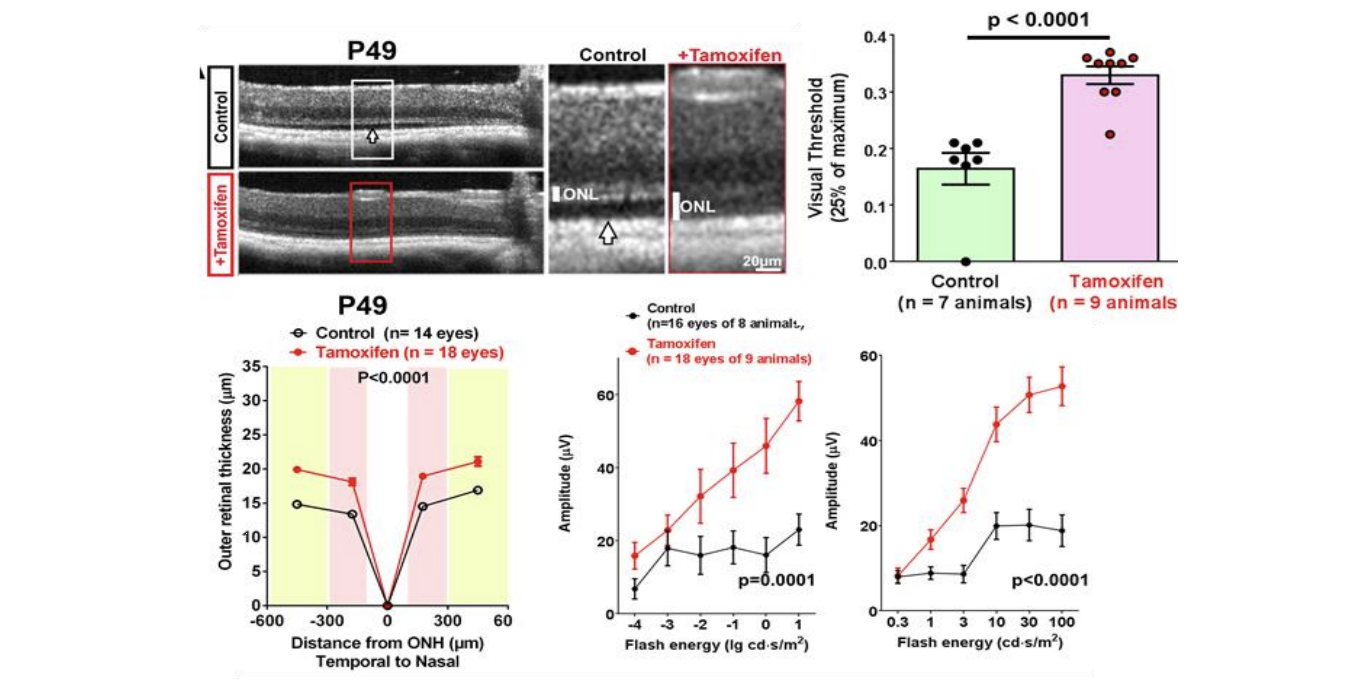
Photoreceptor degeneration is a cause of irreversible blindness in retinal diseases such as retinitis pigmentosa (RP) and atrophic age-related macular degeneration. Tamoxifen, a selective estrogen receptor modulator (SERM) approved for the treatment of breast cancer, exhibits protective effects against photoreceptor degeneration. The mechanism of protection involves modulation of microglial activation and the production of inflammatory cytokines. Tamoxifen along with others in the family of SERMs may be suitable for clinical study as a potential treatment for diseases involving photoreceptor degeneration.
Competitive Advantage:
- Efficacy: Tamoxifen administration provides structural and functional rescue of photoreceptor degeneration in two different mouse models of photoreceptor degeneration.
- Translation ready: The dose range of tamoxifen-mediated neuroprotection has been established in this invention. Tamoxifen is FDA-approved for the treatment of estrogen receptor-positive metastatic breast cancer therefore translation to the clinic for a new indication can happen rapidly. Additionally, drugs targeting Retinitis Pigmentosa fall under orphan indication thereby qualifying for market exclusivity.
- Expanded class: Tamoxifen protective activity has been extrapolated to larger class of SERMs including Raloxifene.
Developmental Stage: Structural and functional protective effects of Tamoxifen have been found in an acute model of lightinduced photoreceptor injury model as well as in a genetic model for RP, rd10. Inventors have determined that Tamoxifen exerts this therapeutic effect by modulation of retinal microglial activation. They are working towards targeted delivery of tamoxifen to the retinal cells.

Tamoxifen administration provides structural and functional rescue of photoreceptor degeneration in rd10 mouse model for RP. OCT imaging demonstrates marked thinning of the ONL and emergence of local retinal detachments that was preserved by Tamoxifen treatment. Tamoxifen treated animals also demonstrated greater b-wave amplitudes in light and dark -adapted responses as well as greater visual threshold indicating greater preservation of visual acuity.
.J Neurosci. 2017 Mar 22;37(12):3294-3310. doi: 10.1523/JNEUROSCI.2717-16.2017. Epub 2017 Feb 24.
Intellectual Property: NEI/NIH has protected intellectual property of this technology (E-134-2016) which is available for development, non-exclusive/exclusive license consideration.
Resources
- Tamoxifen Provides Structural and Functional Rescue in Murine Models of Photoreceptor Degeneration. J Neurosci. 2017 Mar 22;37(12):3294-3310. doi: 10.1523/JNEUROSCI.2717-16.2017. Epub 2017 Feb 24.
- Microglial phagocytosis of living photoreceptors contributes to inherited retinal degeneration. EMBO Mol Med. 2015 Sep;7(9):1179-97.
- Adaptive Müller cell responses to microglial activation mediate neuroprotection and coordinate inflammation in the retina. J Neuroinflammation. 2011 Dec 7; 8:173.
- The selective estrogen receptor modulator raloxifene mitigates the effect of all-trans-retinal toxicity in photoreceptor degeneration. J Biol Chem. 2019 Jun 14;294(24):9461-9475.